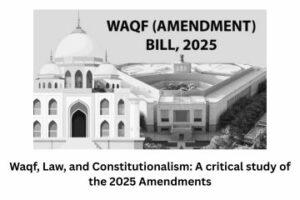Historical Perspectives of Right to Maintenance under Hindu Law
The history of humanity witnessed that woman has been an important factor in the persistence of human society, yet she has been always deprived of her rights even in her mother’s womb. Hindu shastric laws depicted that, it is only a son who can perform the funeral rites of his father and help him to go to heaven. Aitareya Brahmana narrated that, a girl child is a source of misery and it is only a son who is the saviour of the family. The people in search of heaven and to break away from hell always pray for a son which deprives the right of birth of a girl child. But women are always suppressed and confined to the four corners of the house.
They are always considered as inferior to men. For the smooth functioning of a society it is necessary to make a balance between men and women; to pay equal respect to each of them. To construct a society both males and females play a vital role as they are the pillars of the society. The famous jurist John Stuart Mill mentioned the development of human potential for the growth of social and political institutions in society. He narrated that, inequality prevails between men and women and the marriage laws that prevail in society are a responsible factor for such inequality. The lack of education and professional opportunities among women has also narrowed down their empowerment. So, to improve the social and economic condition of women, he emphasized the greater opportunities of education and professional opportunities for women.
He believed that it is only education that can free them from domesticity and make them free to live a life of their own choice. Edification among women will help to cultivate the development of society as a whole. Alongside he also viewed; the family as an institution of equality between man and woman and there is mutual respect and obedience among them. But another jurist Aristotle believed that a hierarchal system prevails in the nature of the human race. He viewed that, the state comprises households which is based on two fundamental distinctions; the difference between male and female including the children, and the ruler and the ruled. Aristotle considered the man as a superior human being over the woman as he controlled the family affairs.
Man being the head of the family and father of his child takes every decision of the house, and woman is only meant for procreation and household activities. He based this theory on the natural differences between man and woman; he argued that on the very basis of nature as a ruler of the household, man is always considered to be superior. Therefore, according to his opinion, there is no inequality for women as the very fact of being a ruler in the family the man will be superior to a woman. However, apart from the juristic views the shastras also depicted the concept of equality among men and women. The Manusmriti also known as Manava Dharmasastra rightly depicted that, the Lord divided his body into two parts; half male and half female and thus universe was created. Society becomes complete when both of them tie the knot together and set up a family which is the basis for all of us.
The concept of the Hindu joint family emerged from the ancient patriarchal family setup and is a miniature of societal organisation, which can be termed as the earliest unit of human society and retains a close connection between the domestic groups of people. These people relate to each other by consanguine relationship, as they belong to the same ancestor. They share common customary rites and rituals and belong to the same clan and kinship group. The relationship between the members of the family is a combination of emotional bonds, self-sacrifice, respect for each other, mutual trust and duties for the kin groups.9 The family institution coupling with marriage provides certain rights and obligations to the members of the family perpetually, as it is believed that, family is an ancestry which stays with us forever. In the beginning of the joint family system, it was always the male members who played a prominent role in maintaining all the family members including their wives, as the patriarchal setup always governed the womenfolk and did not provide equal status to them.
The status of women starting from the Vedic period to Medieval India was mentioned as dependent on the menfolk, since in those days men were the bread earners in the family and women had the responsibility of household chores. The patriarchal belief and traditional practices of the society show that after the solemnisation of the marriage, the bride accompanies the bridegroom and lives with him in the matrimonial home, which earlier was the home of the husband. The husband along with other male members of the matrimonial home earns for their wives and other members of the family. Therefore, in those days, the responsibility of maintenance was on the husband to maintain their wife, since only the male members used to earn for the whole family.
In the Hindu joint family system the eldest male member, known as the Karta had the responsibility to earn for the family members. The ancient Hindu jurisprudence also mentioned that it is the Karta or manager of a Hindu joint family, who is under a legal obligation to earn and maintain all the members of their respective family. In Bhagwan Singh v. Mst. Kewal Kaur, the court held that the obligation of a male Hindu to maintain his relationships is entirely personal in character since it arises from the very existence of the relationship between the parties.
Under Hindu law, the wife enjoys the status of being a member of the matrimonial family, and due to the jural relationship between the husband and the wife, she becomes entitled to maintenance from her husband. This matrimonial remedy cannot be evaded by any arrangement purposely made for fraud. The Mitakshara and Dayabhaga School of the Hindu law also depicts the right of maintenance by the wife from her husband, and when the husband dies she steps into the shoes of her deceased husband and becomes a Class I heir and sharer in the property of her husband. In such circumstances, she can claim the share of an undivided property of the Hindu joint family and she can also claim partition. In addition to this, she also becomes the owner of the self-acquired property of her deceased husband.
The Hindu Jurisprudence also mentioned the responsibility of the father-in-law to provide maintenance to the daughter-in-law. However, if the father-in-law does not possess any ancestral property and has only self-acquired property, he is not legally bound to maintain his daughter-in-law. On the other hand, if he dies then his son/daughter or widow would be legally bounded to maintain the widowed daughter-in-law. Apart from this, a widow who becomes unchaste loses her right to maintenance. However, if she gives up the life of an unchaste then she becomes entitled to bare maintenance.
According to Kattayana, when a husband dies leaving behind the undivided property, in that case, the widow is entitled to food and share in the ancestral property. Kattayana also stated that an heir is bound to maintain the person, which was earlier the legal or moral responsibility of the deceased to maintain and for this reason, the heir receives property from the deceased. It implies that, after the death of the father, the son is responsible for maintaining his mother and unmarried minor sister of his family, since he is the legal heir of his father and it was the legal duty of his father to give maintenance to them.
Manusmriti also depicts the responsibility of the brothers towards their unmarried sisters. It mentioned that in the Hindu joint family each of the brothers shall give one-fourth of their share to the unmarried sisters, which means that, for financial and economic stability, the women are given shares from the joint family property. The responsibility towards the mother is also laid down in Subbarayana v. Subbakka where the court held that the son is obliged to maintain his aged mother irrespective of the possession of the property of his father. The concept of possession of the property is beautifully written by Narada, he mentioned that if any one of several brothers dies without issue or becomes ascetic then the rest of the brothers should take the property and give maintenance to his wife till her death until she behaves otherwise. Since the estate of the deceased to which he has an interest during his lifetime is succeeded by the living brothers.
Keywords: Historical Perspectives of Right to Maintenance, Historical Perspectives of Right to Maintenance in India, Historical Perspectives of Right to Maintenance under Hindu Law




